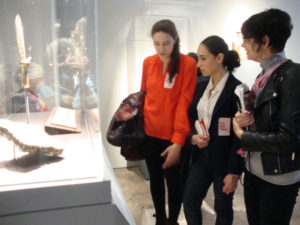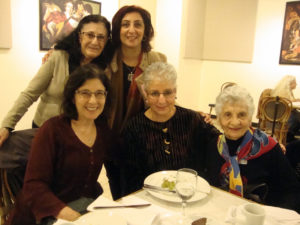 A small group from the National Association for Armenian Studies and Research (NAASR) recently visited New York to witness Armenia! and the Symposium: Honoring the First Scholars of Armenian Art in America at The Metropolitan Museum of Art.
A small group from the National Association for Armenian Studies and Research (NAASR) recently visited New York to witness Armenia! and the Symposium: Honoring the First Scholars of Armenian Art in America at The Metropolitan Museum of Art.
During the four-hour journey to New York, independent artist, art conservator, and NAASR’s Library Curator Ani Babaian, introduced a brief history of Armenian art. Babaian noted that the second most important pilgrimages were made to the fourth century Saint Garabed Monastery, northwest of Moush, which was founded by St. Gregory the Illuminator. Babaian also shared the history of Armenian gold and reflected on the global influences of New Julfa and Amsterdam.
Once the bus arrived in New York, the group eagerly entered The Met Fifth Avenue to attend the day-long symposium in the Grace Rainey Rogers Auditorium.
The symposium focused on various monuments, paintings, manuscripts, and unique items that portray the Armenian impact on international trade during the Middle Ages and its artistic global outreach. Mark Momjian, Chairman of the Board of Directors at the Armenian Center at Columbia University (the organizer of the symposium) delivered the opening remarks. Dr. Helen C. Evans, the Mary and Michael Jaharis Curator for Byzantine Art at The Met and curator of Armenia!, recognized and honored three special professors for their pioneering efforts in starting Armenian Studies programs. Dr. Richard G. Hovannisian and Dr. Nina G. Garsoian were welcomed onto the stage, and Dr. Thomas F. Matthews, who was unable to be attend, was represented by his student, who read a prepared statement. Dr. Sirarpie Der Nersessian, Dr. Vartan Gregorian, and Prof. Hovhaness were also acknowledged.
Symposium speakers, all top-notch with impressive resumes, shared unique presentations connected to many items on display in The Met Armenia! exhibit. First, Dr. Benjamin Anderson spoke on “The Great Kosmos of All Armenia: On the Sarcophagus of Isaac (Sahak).” Dr. Lynn Jones spoke about the censers from Medieval Armenia.
 After a short lunch break, the afternoon program commenced with Dr. Antony Eastmond’s talk on “Stepanos Orbelian and Monumental Painting in Armenia under the Mongols” and Dr. Kristina L. Richardson’s “Portrait of an Armenian Merchant Family in the Diary of a 16th Century Aleppine Silk-Weaver.” Intense international research by Dr. Sebouh Aslanian was evident in his topic, “Their Commercial Arms Stretched over Europe: New Julfa and the Khwaja Guerak-Mirman Family of Venice and Isfahan.” The symposium concluded with Dr. Peter Balakian’s “The Ruins of Ani: From Sacred Landscape to Political Soil.” The symposium was live-streamed and is available in two parts on The Met’s Facebook page. The Armenia! exhibit book, already in its second printing, will be available through NAASR in the near future.
After a short lunch break, the afternoon program commenced with Dr. Antony Eastmond’s talk on “Stepanos Orbelian and Monumental Painting in Armenia under the Mongols” and Dr. Kristina L. Richardson’s “Portrait of an Armenian Merchant Family in the Diary of a 16th Century Aleppine Silk-Weaver.” Intense international research by Dr. Sebouh Aslanian was evident in his topic, “Their Commercial Arms Stretched over Europe: New Julfa and the Khwaja Guerak-Mirman Family of Venice and Isfahan.” The symposium concluded with Dr. Peter Balakian’s “The Ruins of Ani: From Sacred Landscape to Political Soil.” The symposium was live-streamed and is available in two parts on The Met’s Facebook page. The Armenia! exhibit book, already in its second printing, will be available through NAASR in the near future.
During the day, there were opportunities for NAASR’s symposium attendees to explore the Armenia! exhibit. Sonia Dixon, a graduate student in art history at Florida State University, heard about the symposium through Dr. Lynn Jones, one of the symposium’s speakers, and was very impressed with Armenia! “Looking at an old wooden door, the lack of symmetry in the details is fascinating and shows the artisan’s talents,” Ms. Dixon remarked. “This is a phenomenal exhibit.”
On the bus ride home on their way through the Bronx, eager NAASR participants, energized to share their thoughts with one another, were facilitated by two brilliant young scholars, Dr. Lisa Gulesserian, Lecturer on Armenian at the Department of Near Eastern Languages and Civilizations at Harvard University, and Julia Hintlian, a PhD student in Religion at Harvard University’s Graduate School of Arts and Sciences. Having just experienced Armenia! and the symposium, these scholars were as excited as other NAASR attendees and happily shared their impressions. Dr. Gulesserian remarked, “We were impressed by the sheer number of artifacts exhibited,” while Ms. Hintlian, who has spent time in Etchmiadzin, reflected on seeing some of the items from Etchmiadzin’s collection now on display thousands of miles away in a different environment and setting.
As they fielded many questions pertaining to the symposium and the Armenia! exhibit, their knowledge and instant responses to questions piqued even further inquiry and discussion.he setting felt more like an upbeat classroom with dynamic interplay and discussions than a humdrum bus ride home. Time flew by as such topics as maps, manuscripts, liturgical vestments and vessels, and the Armenian language were discussed. Sonia Iskenderian said, “This was very interesting. They know their subjects very well, especially the differences between Western and Eastern Armenian and krapar.”
Anahid Mardiros remarked on The Met exhibit, “It was the first cultural representation of Armenia. It was such a wonderful, organized trip. NAASR should do more programs like this.” Sonya Merian chimed in, “I really enjoyed the symposium. I learned so much, for example, about the trade routes. It was beautifully organized; Laura Yardumian did a terrific job organizing the day. It was a very pleasant day from start to finish.”
Artist Marsha Odabashian, who has a studio and gallery in Boston’s South End concurred, “It’s not very often when a bus trip to NY includes three actively engaged experts. Artist and conservator Ani Babaian shared her first-hand knowledge on Armenian art of New Julfa and Isfahan on the way to The Met. Dr. Lisa Gulesserian and PhD candidate Julia Hintlian, on the way home, facilitated a lively open ended discussion on participants’ impressions of the exhibit and the way in which it was presented. The background knowledge, which they generously supplied, on the Armenian language and the art objects themselves added significant depth to the conversation. Without a doubt, the NAASR team arranged a well-organized, delightful, and worthwhile trip to Armenia! – a very important symposium and exhibition in NYC.”
Danny Donabedian, a student at Harvard’s Near Eastern Languages and Civilization program, remarked, “This trip was a great idea. As someone who is unfamiliar with NAASR other than its research in Armenian Studies, I discovered that NAASR has a fun, adventurous side. I thought this trip was extremely rewarding both as a scholar and as an Armenian-American, and I have NAASR’s efforts to thank for that.”
Preserve. Enrich. Inspire. These three words are connected to NAASR’s logo and they were fully represented in this noteworthy experience.



Be the first to comment